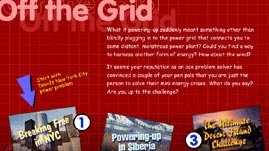Teachers' Domain - Digital Media for the Classroom and Professional Development
User: Preview

Source: Produced for Teachers' Domain
Imagine that in order to play computer games, listen to music, or talk on the phone, you first had to find a way to generate the electricity to power your electronic devices. Most people in the United States access electricity simply by plugging into a wall outlet or flipping a switch. Their homes are connected to power plants through the electrical grid, an extensive network of cables and wires that carry electrical current. However, whether by choice or by circumstance, some people are detached from this grid. This interactive activity produced for Teachers' Domain presents three such scenarios and challenges users to design systems that will generate electricity by harnessing the wind.
In recent decades, it has become increasingly clear that fossil fuels will one day be in short supply. In addition, burning fossil fuels has hidden costs in the form of environmental degradation. To combat rising energy prices and to ease environmental threats such as global warming, some countries and individuals have begun turning to renewable forms of energy, such as the wind. Unlike fossil fuels, wind is inexhaustible. As long as the Sun continues to shine, the wind will continue to blow, and where the wind blows reliably it offers an endless supply of clean energy. Harnessing that energy to generate electricity on a large scale, however, requires careful planning and a high degree of technological innovation.
For centuries, people have used windmills to transform wind energy into more usable forms of energy. The principle is fairly simple. As wind passes over the blades of a windmill, it causes the blades — and the entire rotor assembly to which they are attached — to turn. In this way, traditional windmills convert wind energy into mechanical energy, which has generally been used to grind grain or pump water. Modern windmills, called wind turbines, are based on the same principles as these traditional windmills, but they use the wind energy they capture to turn electrical generators and produce electrical current.
Although wind is free, generating electricity from the wind is not. Modern wind turbines, as well as the towers on which the turbines are mounted and the electrical components that make up a wind power system, are expensive. Engineers who develop these systems — from a single, small wind turbine for one family to hundreds of turbines for a large community — must consider a variety of factors to determine if such a system is economically feasible in a particular area.
The most important considerations for an engineer developing a wind power system are the reliability of the wind in the area, the power output of various sizes of wind turbines, and the power needs of the household or community being served. A small difference in wind speed or windmill size translates into a large difference in both the productivity and the cost-effectiveness of a system. Because of this, engineers carefully consider the benefits and costs of various sizes of windmills. They also weigh the wind speed benefits of placing wind turbines high above the ground against the financial cost of the tall towers on which the turbines are placed.
In addition to these economic considerations, engineers must also consider factors such as zoning restrictions, the effect of wind turbines on hawks, eagles, and other birds, the noise created by wind-driven generators, and the potential for wind turbines to obstruct the flight paths of local air traffic. People who develop large-scale wind farms must also consider whether consumers are willing to pay for wind-generated power even if it costs more — at least to start — than electricity generated by fossil fuel-burning power plants. Only then will wind begin to take its place as a legitimate alternative to fossil fuels.
 Loading Standards
Loading Standards Teachers' Domain is proud to be a Pathways portal to the National Science Digital Library.
Teachers' Domain is proud to be a Pathways portal to the National Science Digital Library.
